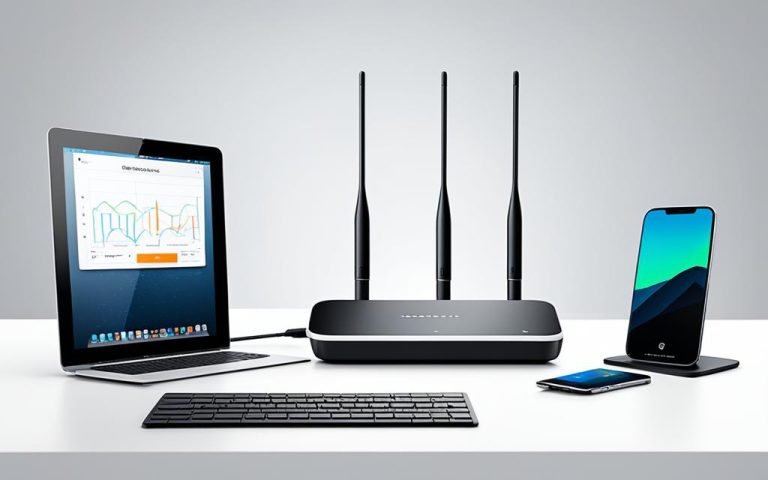The efficient exchange of data in personal area networks (PAN) is crucial for seamless connectivity and improved communication among various devices. To achieve PAN interoperability, the adoption of universal protocols is essential. These protocols standardize data collection and transmission systems, ensuring easy access to accurate and extensive health data.
The lack of comprehensive standards and interoperability in healthcare systems hinders improvements in medical treatment, public health, decision-making, and research. The COVID-19 pandemic has underscored the urgency of data exchange and the need for interoperable standards.
Emerging technologies in healthcare, such as wearable devices and artificial intelligence, rely on interoperable standards for accurate collection and exchange of complex data. However, challenges such as the customization of healthcare systems and the lack of coordination among stakeholders pose obstacles in implementing interoperability.
To drive progress in PAN interoperability, leadership commitment, collaboration, and routine usage of interoperable solutions are crucial. By addressing these challenges and implementing universal protocols, seamless connectivity and improved communication across diverse personal area network devices can be achieved.
The Importance of Interoperability in Healthcare
The achievement of interoperability in healthcare is crucial for overcoming the challenges faced by the USA in providing seamless and efficient healthcare services. Currently, healthcare systems grapple with the inability to answer basic questions about patient variables and rely on outdated communication methods like paper and fax. This lack of interoperability within and across healthcare systems, laboratories, public health programs, and research data resources hinders advancements in medical treatment, public health initiatives, decision-making processes, and research outcomes.
Comprehensive and centrally coordinated data collection and transmission standards that are enforceable are needed to tackle the existing hindrances. It is evident that relying on non-binding standards for data management and exchange can have dire consequences, as exemplified by the COVID-19 pandemic. The successful incorporation of emerging technologies in healthcare, such as wearable devices and artificial intelligence, heavily depends on the availability of interoperable standards to ensure accurate and efficient data exchange.
Interoperability in healthcare can only be achieved through strong leadership commitment, collaboration, and the routine implementation of interoperable solutions. It is imperative to recognize the significance of interoperability in breaking down barriers within healthcare systems, facilitating seamless data exchange, and ultimately enhancing patient care and outcomes.
Efforts towards establishing interoperability standards must be prioritized to eliminate data silos, reduce inefficiencies, and improve the overall quality of healthcare delivery.
Challenges in Achieving Interoperability
The lack of interoperability in healthcare stems from various challenges, including the customization and proprietary nature of healthcare systems. These factors contribute to inconsistencies and confusion in data exchange. In addition, inefficient coordination and communication among government organizations, healthcare system vendors, software developers, and other stakeholders further impede interoperability.
Highly customized and proprietary healthcare systems give rise to jurisdictional conflicts, hindering the identification of critical data facts. This lack of standardization makes it difficult to establish a common, enforceable, and well-documented data structure and coding across different healthcare systems and application programming interfaces. As a result, data exchange becomes complex and error-prone.
The tolerance for unnecessary customization and the absence of coordination among responding organizations exacerbate the challenges in achieving interoperability. These issues undermine the seamless connectivity and smooth communication needed to optimize healthcare systems.
Addressing these challenges requires a systematic approach that emphasizes the importance of standardized practices, collaboration among stakeholders, and effective coordination in healthcare systems. By streamlining processes and aligning efforts towards interoperability, the healthcare industry can unlock the full potential of data exchange and improve patient care outcomes.

Challenges in Achieving Interoperability
| Challenges | Description |
|---|---|
| Lack of Coordination | Inefficient coordination and communication among stakeholders impede interoperability efforts. |
| Customization of Healthcare Systems | Highly customized and proprietary healthcare systems hinder data exchange and standardization. |
| Conflicting Jurisdictions | Jurisdictional conflicts arise due to variations in healthcare systems, making it difficult to identify critical data facts. |
| Complex Data Exchange | The lack of common, enforceable, and well-documented data structure and coding complicates data exchange processes. |
The Role of Governance in Interoperability
Governance structures play a crucial role in addressing interoperability challenges. Effective governance facilitates communication, coordination, cooperation, and the establishment of guidelines and principles. It involves federal, state, local, tribal, and territorial entities, as well as representatives from emergency response disciplines.
Governance structures drive the enhancement of emergency communications capabilities and support proactive measures to manage cybersecurity risks, expand training and exercise participation, improve policies and procedures, and design continuity and resiliency measures. Funding decisions made through governance structures affect the five elements of interoperability.
Leadership commitment, collaboration, and resource support from policymakers are essential for effective governance in achieving interoperability.
By fostering strong governance, organizations can effectively address the challenges hindering interoperability and promote seamless connectivity among personal area network devices and protocols.
Benefits of Governance in Interoperability:
- Promotes collaborative decision-making processes
- Facilitates effective communication and coordination among stakeholders
- Establishes guidelines and principles for interoperability
- Supports proactive measures to manage cybersecurity risks
- Enhances emergency communications capabilities
Effective governance is essential for achieving interoperability and ensuring successful data exchange and communication in personal area networks.
“The success of interoperability heavily relies on strong governance structures that foster collaboration, communication, and decision-making among stakeholders.”
| Key Elements of Governance in Interoperability | Role |
|---|---|
| Leadership commitment | Provides guidance and support for interoperability initiatives |
| Collaboration | Fosters cooperation and coordination among stakeholders |
| Effective communication | Facilitates information sharing and decision-making processes |
| Decision-making | Ensures strategic and informed decisions for interoperability implementation |
Standard Operating Procedures and Guidelines for Interoperability
Standard operating procedures (SOPs) and guidelines play a crucial role in achieving interoperability in various emergency response activities. SOPs provide formal written instructions and practices for incident response, ensuring a standardized approach and effective coordination among agencies and jurisdictions. These procedures outline the steps and protocols that responders need to follow when addressing emergencies, enabling a swift and efficient response.
On the other hand, standard operating guidelines (SOGs) offer policies and procedures that allow responders flexibility based on situational needs. They provide responders with a framework to adapt and make informed decisions based on the specific circumstances they encounter. By incorporating these guidelines, responders can effectively address the unique challenges they face during incidents while maintaining interoperability with other agencies.
Field operations guides (FOGs) are another essential component of interoperability. These guides provide detailed information and resources on interoperable communications, enabling responders to effectively communicate and collaborate across different agencies and jurisdictions. FOGs serve as a comprehensive reference for responders, ensuring they have access to the necessary tools and technologies for seamless communication.
In order to achieve effective multi-agency response and maximize interoperability, it is crucial to coordinate and share SOPs, SOGs, and FOGs among agencies and jurisdictions. This sharing of resources ensures that all responders are aligned and aware of the established procedures, guidelines, and interoperable communication protocols. Lack of coordination in this regard can hinder a cohesive and efficient emergency response, leading to the potential loss of valuable time and resources.
By developing joint SOPs, SOGs, and FOGs for events and incidents, as well as regional SOPs and FOGs, emergency response agencies can enhance interoperability. Adhering to the National Incident Management System (NIMS) framework further promotes consistency, effectiveness, and safety in emergency response activities across different jurisdictions and agencies.
| SOPs | SOGs | FOGs |
|---|---|---|
| Formal written instructions and practices | Policies and procedures with situational flexibility | Detailed resource information for interoperable communications |
| Ensure standardized approach and coordination | Allow adaptability and informed decision-making | Facilitate effective communication and collaboration |
| Shared among agencies and jurisdictions | Enhance multi-agency response | Serve as a comprehensive reference for responders |
| Promote interoperability and consistency | Maximize interoperability | Support seamless communication |
Overall, SOPs, SOGs, and FOGs are crucial tools in ensuring interoperability in emergency response. These standardized procedures, guidelines, and resources enable responders to effectively address incidents while maintaining seamless communication and collaboration across agencies and jurisdictions.
Technology and Interoperability
Technology plays a crucial role in improving interoperability within personal area networks. However, it is important to note that technology alone is not the sole driver of an optimal solution. Successful implementation of data and voice communications technology requires a foundation of strong governance, effective collaboration, and comprehensive training among participating agencies and jurisdictions.
When choosing technologies for interoperability, it is essential to consider the specific needs of front-line practitioners and address regional requirements. The technology should align with existing infrastructure, provide a cost vs. benefit advantage, and ensure long-term sustainability.
Scalable technologies are particularly important as they can support both day-to-day incidents and large-scale emergencies. This scalability ensures that the technology remains effective and reliable regardless of the situation at hand.
However, it is important to remember that technology is only one piece of the puzzle. Strong governance, collaboration, and training are key factors that contribute to the successful implementation and utilization of technology in achieving interoperability.
“Technology is only one piece of the puzzle. Strong governance, collaboration, and training are key factors in achieving interoperability.”
Collaboration and Training
To fully leverage the potential of technology in achieving interoperability, collaboration among agencies and jurisdictions is vital. Collaborative efforts ensure that different organizations work together seamlessly, utilizing compatible technologies and protocols for effective communication and data exchange.
Moreover, comprehensive training programs are essential to ensure that personnel are well-versed in using the technology and understand how to optimize its capabilities. Proper training improves efficiency, reduces errors, and allows for effective utilization of interoperable communication systems.
The Role of Technology in Data and Voice Communications
Technology plays a significant role in facilitating data and voice communications, enabling seamless information exchange within personal area networks. Through the use of advanced technologies, such as internet protocol (IP) based systems and wireless communication, real-time access to critical information becomes possible.
These technologies allow for quick and efficient sharing of data, enhancing communication and decision-making processes. Whether it is the transmission of medical records or the coordination of emergency response efforts, technology enables effective and rapid information exchange.
| Benefits of Technology in Interoperability |
|---|
| Facilitates real-time communication |
| Enables quick and efficient data exchange |
| Improves coordination and decision-making |
| Enhances overall information flow |
| Promotes seamless connectivity within personal area networks |
By harnessing the power of technology, personal area networks can achieve seamless connectivity and efficient data and voice communications. However, it is important to recognize that the successful implementation of technology depends on strong governance, collaboration, and training.
Conclusion
Achieving interoperability in personal area networks (PAN) is essential for improving healthcare outcomes, public health measures, and research. To successfully achieve interoperability, comprehensive standards, coordination, collaboration, and the utilization of interoperable solutions are crucial.
One of the key requirements for achieving interoperability is easy access to accurate health data. With efficient data exchange and standardized data collection and transmission systems, healthcare providers can make informed decisions and improve medical treatment for patients. Additionally, interoperability enables better understanding of public health trends and more effective planning of public health measures.
However, there are challenges that hinder interoperability in PANs. The customization of healthcare systems and the lack of coordination among stakeholders pose significant hurdles. Furthermore, the reliance on non-binding standards and inconsistent data structures complicate data exchange and integration across different systems.
Addressing these challenges requires effective governance and leadership commitment. Collaboration across government organizations and stakeholders is vital for driving progress in achieving interoperability. Furthermore, the implementation of standard operating procedures and guidelines, along with the utilization of technology, plays a crucial role in achieving seamless connectivity and improved communication across diverse personal area network devices and protocols.
By overcoming these challenges and implementing interoperable solutions, the healthcare industry can achieve greater connectivity, improved data exchange, and enhanced collaboration, ultimately leading to better patient care and more efficient healthcare systems.
FAQ
What is interoperability in personal area networks (PAN)?
Interoperability in personal area networks refers to the ability of devices and protocols within a PAN to connect and communicate seamlessly. It involves the use of universal protocols that enable efficient data exchange and standardized data collection and transmission, ultimately improving medical treatment, public health, decision-making, and research.
Why is interoperability important in healthcare?
Interoperability in healthcare is crucial for several reasons. It allows for easy access to accurate health data, facilitates efficient data exchange between healthcare systems, laboratories, public health programs, and research data resources. Through interoperability, medical treatment can be improved, public health measures can be evaluated, and medical errors can be prevented through accurate and extensive health data. It also supports decision-making and research by providing a comprehensive view of patient variables and enables advancements in emerging technologies like wearable devices and artificial intelligence.
What are the challenges in achieving interoperability?
Achieving interoperability in healthcare faces several challenges. Some of these include the lack of coordination and communication among government organizations, healthcare system vendors, software developers, and other stakeholders. Customization and the proprietary nature of healthcare systems contribute to inconsistencies and confusion. The absence of common, enforceable, and well-documented data structure and coding across healthcare systems and application programming interfaces makes data exchange complex and prone to errors. The tolerance for unnecessary customization and the lack of coordination further hinder interoperability.
What is the role of governance in interoperability?
Governance plays a crucial role in addressing interoperability challenges. It involves the coordination, communication, and collaboration among federal, state, local, tribal, and territorial entities, as well as representatives from emergency response disciplines. Effective governance establishes guidelines, principles, and funding decisions, driving enhancements in emergency communications capabilities, proactive cybersecurity management, training and exercise participation, policies and procedures improvement, and continuity and resiliency measures. Leadership commitment, collaboration, and resource support from policymakers are vital in achieving interoperability through effective governance.
How do standard operating procedures and guidelines contribute to interoperability?
Standard operating procedures (SOPs) and guidelines are essential components of interoperability. SOPs provide formal written instructions and practices for incident response, while standard operating guidelines (SOGs) offer policies and procedures that allow responders flexibility based on situational needs. Field operations guides (FOGs) provide detailed interoperable communications resource information. The coordination and sharing of SOPs, SOGs, and FOGs among agencies and jurisdictions enhance effective multi-agency response. Joint SOPs, SOGs, and FOGs, regional SOPs/SOGs and FOGs, and adherence to the National Incident Management System (NIMS) framework promote consistency, effectiveness, and safety in emergency response activities, thus fostering interoperability.
What is the role of technology in achieving interoperability?
Technology plays a critical role in improving interoperability, but it is not the sole driver of an optimal solution. Successful implementation of data and voice communications technology relies on strong governance, effective collaboration, and training among participating agencies and jurisdictions. Technologies should align with the needs of frontline practitioners, address regional requirements, consider existing infrastructure, evaluate cost vs. benefit, and ensure sustainability. Scalable technologies are necessary to support both day-to-day incidents and large-scale emergencies. Strong governance, collaboration, and training are vital for the successful implementation and utilization of technology in achieving interoperability.
In summary, how can interoperability be achieved?
Achieving interoperability requires comprehensive standards, coordination, collaboration, and the utilization of interoperable solutions in personal area networks (PAN). Easy access to accurate health data, efficient data exchange, and standardized data collection and transmission systems are crucial. Challenges in interoperability include the lack of coordination, customization of healthcare systems, and reliance on non-binding standards. Effective governance, with leadership commitment and collaboration across government organizations and stakeholders, plays a vital role in driving progress. Standard operating procedures and guidelines, as well as technology, are key components in achieving interoperability. By addressing these challenges and implementing interoperable solutions, seamless connectivity and improved communication across diverse devices and protocols in personal area networks can be achieved.



















